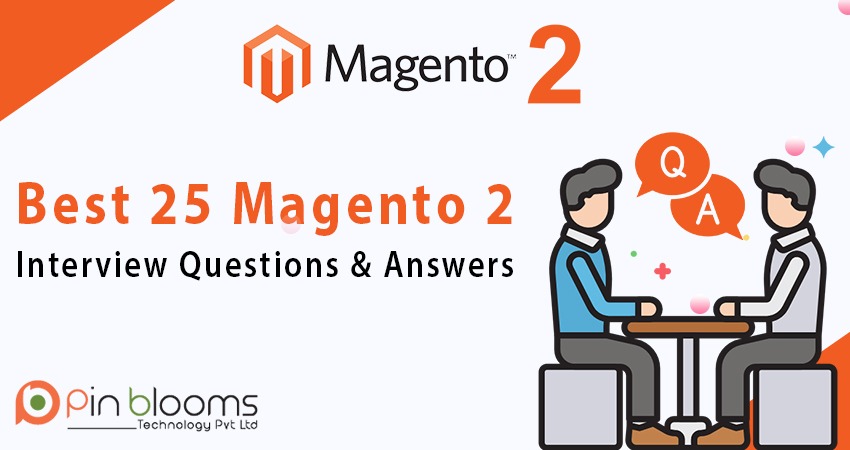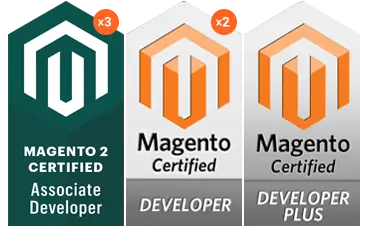Magento 2 Interview is one of the most nerve-racking processes especially the technical ones. Every individual has a fear of being asked questions in the interview. Before going to an interview, it is better to have at least some basic idea of questions that might be thrown at you. Every candidate wants the best Magento 2 interview questions for preparation.
If you are preparing for Magento 2 developer post, then there is a good chance that your interviewer is going to ask. However, we create a list of the best 25 Magento 2 Interview Questions and Answers. These questions may be asked in most companies. So you have to prepare them to excel in your Magento 2 Interview. Moreover, if you are planning to hire the best Magento 2 developer for your company, check out this post from Toptal for Magento Hiring Guide.
When you are preparing for Magento 2 Interview Questions, you must have in-depth knowledge of advanced PHP and GitHub.
Magento 2 Interview Questions and Answers
Here is a list of the best 25 Magento 2 Interview Questions along with their answers:
Question #1: What is Magento 2?
Answer: Magento is an eCommerce platform that helps companies to manage their online store in an optimized way. Magento is an open-source eCommerce management system. It uses multiple PHP frameworks like Laminas and Symfony. It empowers thousands of merchants with exceptional flexibility and functionality of eCommerce stores to innovate and grow.
Question #2: How many design patterns does Magento 2 have?
Answer: Magento 2 have 20 design patterns:-
- Model View Controller Pattern
- Front Controller Pattern
- Factory Pattern
- Singleton Pattern
- Registry Pattern
- Prototype Pattern
- Object Pool Pattern
- Iterator Pattern
- Lazy Loading Pattern
- Service Locator Pattern
- Module Pattern
- Observer Pattern
- Object Pattern
- Service Contract Design Pattern
- Injectable Objects
- Non Injectable Objects
- Dependency Injection
- Factory Pattern or Factory Classes
- Proxy Pattern
- Active Records
Question #3: What is MVC architecture?
Answer: MVC stands for Model-View-Controller. It is a framework that is used to separate the data access, user interface, and business logic.
- Model:- It is the system modeling level. It is used to maintain system business rules and data persistence.
- View:- This is responsible for the user information display layer like product page, contact form, etc. It is maintained through layout files that connect blocks, containers, and UI components to display into a page by a browser.
- Controller:- This layer defines the main actions, requests, and responses of the clients. Moreover, it may change the model’s state and generate data views of the model layer.
Question #4: Which scripting language supports Magento 2?
Answer: Magento uses MySQL 5+, Percona, MariaDB, Oracle for database, and PHP 5.4+ as a web server scripting language.
Question #5: How can you improve the performance of Magento 2?
Answer: Here are several techniques to improve the performance of Magento 2:-
- Enable Flat Categories and Products (This will be applicable when the store owners want to show limited product information on the frontend.)
- Minify CSS and JS
- Merge CSS
- Content Delivery Network (CDN)
- Enable Caching (Varnish/Redis)
- Image Optimization
- Reduce Server Response Time
- Audit Magento code
- Prioritize Above the fold content
- Reduce the size of visible content
- Run store in production mode
- Optimize shipping rates collection
- Perform 3rd party Extensions Audit
- Upgrade to PHP latest version
Question #6: How to enable or disable a Magento 2 module?
Answer: Run the following commands to enable or disable a Magento 2 module:-
For enable:-
php bin/magento module:enable module_nameFor disable:-
php bin/magento module:disable module_nameQuestion #7: What are the different deploy modes in Magento 2 and explain their differences?
Answer: There are 3 Magento 2 modes: Default, Developer, and Production mode.
- Default:- The Magento 2 site is always on default mode when there is no mode is specified. We can deploy the application on a single server without any changes in the settings.
- Developer:- The developer mode is used whenever you are customizing or extending the Magento 2’s default functionalities. It automatically compiles the code and debugging.
- Production:- The live Magento website should be in production mode. In production mode store become secure and all error logged.
Question #8: How to change your current Magento’s site mode?
Answer:- Run the following command:-
php bin/magento deploy:mode:set {mode}Mode:
- default
- developer
- production
Question #9: How to show mode in Magento 2?
Answer: Run the following command to show mode in Magento 2:-
php bin/ magento deploy:mode:showQuestion #10: How to add a new theme in Magento 2?
Answer: Here are the following steps to install the Magento 2 theme:-
Step 1:- Download theme
Step 2:- Upload the new theme to the server
Step 3:- Run Upgrade
php bin/ magento setup:upgradephp bin/ magento setup:static-content:deployStep 4:- Choose a new theme in the backend
Step 5:- Then finally, Setup the theme to your store
Question #11: How to change the core Magento API settings?
Answer: Here are the following steps to change the core Magento API settings:
Step 1:- Go to Admin menu
Step 2:- Select System> Configuration
Step 3:- Choose Magento Core API on the left side of the panel under service.
Step 4:- Go to General settings and expand it.
Step 5:- Now enter the details of Default Response Charset
Step 6:- Enter the Client Session Timeout (in secs)
Step 7:- Select yes to enable WS-I Compliance and WSDL Cache.
Step 8:- Click on Save button.
Question #12: Define static blocks in Magento 2?
Answer: Static blocks in Magento 2 are the sections of the content within a page. We can create static blocks of content to implement in various places of the web applications. You can reuse the blocks on multiple pages and locations that saves lots of time when creating and updating content.
Question #13: Describe the Magento module based architecture: EAV
Answer: The Entity, Attribute, Value model, also known as entity-attribute-value or Open Schema, is a database or catalog management system that is used in Magento. EAV was designed for databases where there might be a large number of attributes that define a certain entity, but not all of these attributes might apply to that entity.
Question #14: How many tables are created after the generation of a new EAV model?
Answer: For a new EAV model, 6 tables are created:-
- module
- module_datetime
- module_decimal
- module_int
- module_text
- module_varcher
Question #15: What are the system requirements in Magento 2?
Answer: Following are the system requirements in Magento2
- Web services Requirements
- Apache 2.2 or 2.4
- Nginx 1.x
- Database Engine Requirements
- MySQL 5.6, 5.7
- MariaDB 5.6, 5.7
- PHP Requirements
- >= 7.1.3
- >= 7.2.0
- PHP extensions requirements
- bcmath
- ctype
- curl
- dom
- gd
- hash
- iconv
- intl
- mbstring
- OpenSSL
- pdo_mysql
- simplexml
- soap
- SPL
- XSL
- zip
- libxml (lib)
- Cache system Requirements
- PHP OPcache (Recommend)
- Redis
- Vanish
- mem-cached
- Email services Requirements
- Mail Transfer Agent (MTA)
- SMTP server
- SSL Requirements
- A valid security certificate is required for HTTPS.
- Transport Layer Security (TLS) requirement
Question #16: How can we remove Magento 2 extension?
Answer: Here are the following steps to remove the Magento 2 extension from the store:-
Step #1:- Connect via SSH to the root of the Magento installation
php bin/magento module:statusStep #2:- Disable the extension
php bin/magento module:disable<ExtensionProvider_ExtensionName>php bin/magento setup:upgradeStep #3:- Remove the extension
cd app/code/<ExtensionProvider>/rm -rf <ExtensionName>Step #4:- Refresh your website homepage
Question #17: What is Magento 2 web API? What are the uses of Magento 2 API?
Answer: It is a framework that allows the user integrators as well as developers to connect with the Magento system. Both REST and SOAP are supported. Any third-party service and Magento can be configured as a web API with the help of XML. Moreover, you need to define the XML elements and attributes in a webapi.xml configuration file.
You can use the Magento web APIs to perform the various tasks:-
- You can build an online store and connect them with a physical system like POS to control the inventory worldwide.
- Easily Integrate with CRM and ERP backend systems including Salesforce, Microsoft Dynamics, Xero, and many more.
- Create JavaScript widgets that make AJAX access services can be created on the admin panel.
- You can easily integrate with a CMS.
- You can create a shopping app so that the users can download it on their mobile apps.
Question #18: What is the best way to count the items in a collection? Which is the best method?
Answer:- There are 2 ways to count the items in a collection:- getSize() method and count() method. getSize() method is preferred as one of the most efficient methods. Because it saves the load time of collection again and again wherever there is a need to count items.
Question #19: What is the difference between Multi-channel marketing and Omni-channel marketing?
Answer: Difference between Omni-Channel Marketing and Multi-Channel Marketing:-
| Omni-Channel Marketing | Multi-Channel Marketing |
| Omni-Channel is a form of marketing that refers to all the channels. | Multi-Channel is a form of marketing that refers to multiple channels. |
| It always focuses on maximum customer experience. | It always focuses on maximum customer engagement. |
| All the channels are connected and interactive with each other. | All the channels are independent and disconnected from each other. |
| Deliver consistently, uniform messaging on all the channels. | Deliver different messaging on different channels. |
| Complete transparency between the channels. | No Transparency between channels. |
| Irrelevant Customer Experience | Seamless Customer Experience |
Question #20: Choose an architectural pattern that allows creating store-specific custom values in the admin panel.
Answer: The feature is available in the Entity Attribute Value (EAV).
Question #21: How to reset Magento file & directory permissions?
Answer: Run the following commands:-
find . –type f –exec chmod 644 {} \;
find . –type d –exec chmod 755 {} \;Question #22: How to create a custom module in Magento?
Answer: Here are the following steps to create a custom module in Magento:-
Step 1:- Create a module directory (Vendor_Modulename).
Step 2:- Create etc/module.xml files for your module.
Step 3:- Then, create the registration.php file.
Step 4: Create composer.json file (Optional)
Step 5:- Run the bin/magento setup upgrade command (./bin/magento setup:upgrade) to install the new module
Step 6:- Ensure that the new module is working properly or not.
Question #23: How to create a Controller in Magento 2?
Answer: Here are the following steps to create a Controller in Magento 2:-
Step #1:- Create routes.xml file
Step #2:- Create a controller file
Step #3:- Create controller Layout file
Step #4:- Create controller Block file
Step #5:- Create controller template file
Step #6:- Flush Magento cache
Step #7:- Run a test new controller
Question #24: What is the widget in Magento 2?
Answer: Widgets are basically one the most powerful functionalities in Magento 2 configuration. It basically helps to improve the storefront under the lively interface by the dynamic block of the content. Some of the implementations of Magento widgets are as follows:-
- Dynamic product data
- Dynamic lists of the recently viewed products
- Promotional banners
- Interactive navigation elements and action blocks
Here are the following steps to build a custom widget in Magento 2:-
Step #1:- Initialize and declare widget in widget.xml
Step #2:- Create a widget template file in Magento 2
Step #3:- Then, Create widget Block class
Step #4:- Flush cache and posts
Question #25: How can we get the first item or last item from the collection?
Answer: Run the following command to get first item or last item from the collection:-
- For First Item:-
$collection->getFirstItem();- For last Item:-
$collection->getLastItem();So, hope you get the best Magento 2 Interview questions along with their answers. If you have more topics about Magento 2 interview questions, then do let us know in the comments below. Moreover, you want any type of Magento development services, please feel free to contact Pin Blooms Technology today.









